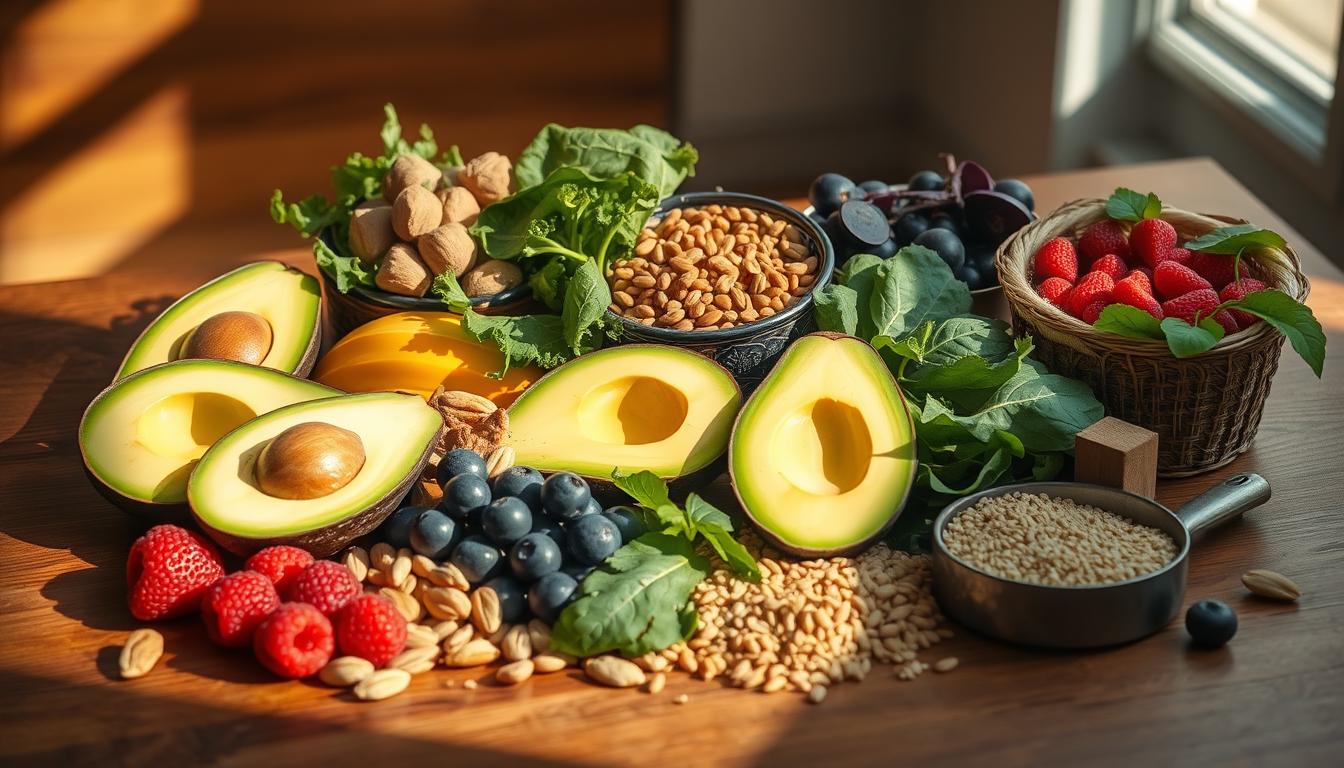“Every day, we have the power to control our blood sugar. Find out the best way to regulate blood sugar and make a positive change.”. For me, learning about blood sugar control became crucial when a loved one got diabetes. Since then, I’ve learned a lot about how to live better and take charge of my health.
Managing blood sugar is not just about numbers or science. It’s about making changes that improve our lives and keep us healthy. Finding the right strategies for controlling blood sugar is key to avoiding serious health issues like heart disease and stroke.
Drinking more water can lower the risk of high blood sugar, showing us the power of simple actions1. Adding something as basic as hydration can make a big difference. Soluble fiber is also important for managing blood sugar, unlike insoluble fiber1. This info helps us make better food choices.
Exercise is another key to controlling blood sugar. A mix of aerobic and resistance training is effective2. Exercise keeps blood sugar levels in check for up to 48 hours after, offering ongoing health benefits2. Even short walks after meals can prevent blood sugar spikes, fitting easily into our daily routines2.
Manage your blood sugar effectively with these tips.
Key Takeaways
- Hydration can significantly decrease the risk of high blood sugar levels1.
- Incorporating soluble fiber into your diet serves as an effective blood sugar control strategy1.
- Engaging in regular exercise is crucial in managing blood sugar levels2.
- Post-meal walks can help in mitigating blood sugar spikes2.
- Proactive lifestyle adjustments can lead to improved health and prevention of long-term complications.
Understanding Blood Sugar and Its Importance in the Body
Blood sugar, or glucose, is vital for our health. It gives energy to our cells. Keeping blood sugar levels in check is key for our organs to work well and for our overall health.
The Role of Insulin in Blood Sugar Management
Insulin is crucial for how our bodies use and store glucose. It acts like a key, letting blood sugar into our cells. When we eat, the pancreas releases insulin to keep blood sugar levels balanced. To improve insulin function and manage blood sugar well, aim for 150 minutes of cardio and two strength workouts a week3.
Complications Arising from Imbalanced Blood Sugar Levels
It’s important to keep blood sugar levels in check. For people with diabetes, levels should be between 80 to 130 mg/dL before meals and under 180 mg/dL two hours after4. If not managed, high blood sugar can cause serious problems like nerve damage, heart disease, and kidney failure. Heart disease is the top cause of death in the U.S., and keeping glucose levels right can prevent these issues3.
Recognizing the Symptoms of Hyperglycemia
Spotting hyperglycemia symptoms early is key to avoiding long-term health problems. Signs include feeling thirsty, tired, needing to pee a lot, and blurry vision4. Catching these signs early helps prevent the risks of high blood sugar.
Always talk to healthcare experts to learn how to manage your glucose levels effectively.
In summary, managing your blood sugar through exercise, diet, and doctor advice leads to a healthier life. It helps you stay balanced and well.
Best Way to Regulate Blood Sugar
Managing blood sugar well means taking a whole-body approach. I find that using natural ways to manage blood sugar works best. These methods fit with different health needs and lifestyles.
About 13% of Americans have high blood sugar, and this number jumps to 25% for those over 655. It’s important to check your blood sugar often, especially if you’re on insulin. Exercise can also change your glucose levels a lot6.
Getting at least 150 minutes of moderate exercise a week is key for managing diabetes6. Adding strength training 2 to 3 times a week helps too. This keeps your blood sugar in check and boosts your health.
- Managing carbs is a big part of controlling your sugar levels, especially if you use insulin6.
- Drinking enough water is also crucial; it lowers the risk of high blood sugar5.
- Minerals like chromium and magnesium help control blood sugar. Not having enough can raise your levels5.
Planning for changes in your health is another smart move. This means adjusting your meds, checking your sugar more, and watching for ketones to avoid spikes6.
| Activity | Frequency | Benefits |
|---|---|---|
| Moderate aerobic exercises | 150 minutes/week | Improves insulin sensitivity and blood sugar levels6 |
| Strength-building exercises | 2-3 sessions/week | Increases muscle mass and boosts metabolic rate6 |
| Hydration (Water intake) | Daily, sufficient to stay hydrated | Lowers the risk of high blood sugar5 |
Customizing these strategies based on your needs and doctor’s advice is key. It helps with managing blood sugar naturally and can make you feel better and live longer. Always talk to a healthcare provider to make these changes right for you.
Comprehensive Exercise Routines for Blood Sugar Control
Managing blood sugar and improving health requires a mix of cardio and strength training. These exercises boost insulin sensitivity and help create a workout plan that fits your life.
Benefits of Weightlifting and Resistance Training
Adding weightlifting and resistance training to your routine can greatly improve insulin sensitivity. It helps muscles use glucose better. These exercises are key for controlling blood sugar, keeping levels low for up to 24 hours after7. Adults should do strength training 2 to 3 times a week, giving muscles time to recover8.
Impact of Cardiovascular Exercises on Insulin Sensitivity
Cardio exercises are vital for better insulin sensitivity and glucose control. Adults should do at least 150 minutes of moderate to vigorous cardio each week8. This type of exercise is good for the heart and helps manage blood sugar.
Developing a Sustainable Physical Activity Plan
Creating a lasting exercise plan means thinking about your fitness, health, and what you like to do. Regular activity lowers A1C levels, helping manage blood sugar over time7. Focus on activities you enjoy and can keep up with, which is key for sticking with it.

It’s important to know how exercise affects your blood sugar, especially if you’re on insulin or diabetes meds7. You might need to adjust your meds or diet to avoid low blood sugar during exercise, especially with intense or long workouts7. Always check your blood sugar levels and adjust snacks and meds as needed to stay safe during and after exercise8.
Manage your blood sugar effectively with these tips.
| Timing of Exercise | Blood Sugar Level (mg/dL) | Recommended Action |
|---|---|---|
| Before Exercise | Lower than 90 | Consume a small snack |
| Before Exercise | 90-124 | Take 10 grams of glucose |
| Before Exercise | 126-180 | Ready to exercise |
| During Exercise | 70 or lower | Stop and consume fast-acting carbohydrates |
| After Exercise | Varies | Monitor and consume carbohydrates if needed |
Listening to your body and adjusting based on your blood sugar levels is key to safe and effective exercise for managing blood sugar. It’s also wise to test your blood sugar every 30 minutes while exercising, especially for long or new activities8.
Strategizing Your Diet for Blood Sugar Regulation
Controlling blood sugar naturally means understanding diet and blood sugar well. It’s key to manage carbs and sugar intake with consistent dietary strategies. By focusing on food quality and balancing food groups, you can keep your blood sugar stable all day.
The American Diabetes Association says eating a variety of vegetables helps manage blood sugar9. Also, eating fish like salmon and mackerel twice a week is good for your heart and blood sugar9. These foods help control blood sugar and lower heart disease risk9.
A balanced diet with non-starchy veggies, lean proteins, and whole grains helps stabilize blood sugar. Foods high in fiber like fruits, legumes, and nuts slow digestion. This helps manage blood sugar spikes after eating9.
| Food Group | Benefits | Examples |
|---|---|---|
| High Fiber Foods | Slows digestion, controls blood sugar | Fruits, Vegetables, Nuts, Legumes, Whole Grains |
| Omega-3 Rich Fish | Supports heart health, aids in blood sugar regulation | Salmon, Mackerel, Tuna |
| Lean Proteins | Stabilizes blood sugar, promotes satiety | Chicken, Turkey, Legumes |
Controlling portions and choosing quality carbs is key for managing blood sugar9. Using the glycemic index to pick foods helps those with diabetes9.
Working with healthcare providers and dietitians for a personalized meal plan is crucial9. Medical nutrition therapy offers detailed dietary advice and might be covered by insurance10.
Creating a strategic diet plan helps manage carbs and sugar and boosts overall health. By focusing on balanced meals and expert advice, you can overcome diabetes challenges and improve your life quality.
Maximizing the Benefits of a High-Fiber Diet
Going on a high-fiber diet is more than a trend; it’s a big change for better health, especially for those with blood sugar issues. Knowing about soluble and insoluble fiber and adding the right amount to your meals can boost your health a lot.
Differentiating Soluble and Insoluble Fiber
The fight between soluble versus insoluble fiber is key to knowing how they help our bodies. Soluble fiber, found in oats, apples, and beans, mixes with water and lowers blood sugar and cholesterol. On the other hand, insoluble fiber, in foods like wheat bran and veggies, helps with digestion and stops constipation.
Identifying Fiber-Rich Foods for Daily Consumption
Getting enough fiber is crucial for blood sugar control, and there are many foods full of it. Good sources of soluble fiber are black beans and artichokes, while great sources of insoluble fiber are lentils and almonds. Eating a mix of these foods is key to enjoying the benefits of a high fiber diet.
Daily Recommended Fiber Intake and Its Effects
To get the most health perks, aim for the daily fiber intake of 25 grams for women and 38 grams for men under 50, and 30 grams for older men11. Meeting this goal can lower the risk of type 2 diabetes and heart disease, and help with weight control by making you feel full longer1112.
In summary, eating a diet full of both soluble and insoluble fiber from various foods is key for good health, especially in managing blood sugar and lowering disease risks. Slowly adding more fiber to your meals and eating a variety each day will help you get the most benefits without stomach issues12.
Effective Hydration for Natural Blood Sugar Management
Hydration is key to managing blood sugar levels, especially for those wanting to lower diabetes risk. This part explains how drinking water helps the body control blood sugar.
Water is vital for life and helps manage blood sugar. It helps process glucose and removes excess sugar through urine. This is important for avoiding high blood sugar.
Drinking water regularly can significantly contribute to diabetes risk reduction by helping regulate glucose levels and supporting overall kidney health.
Studies show that drinking water often lowers the risk of high blood sugar. This highlights the importance of drinking water in preventing diabetes13.
Hydration also links to diet and lifestyle. Eating foods like cucumbers, tomatoes, and watermelons helps with hydration. These foods are a natural choice over sugary drinks that can raise blood sugar.

| Tip | Description | Impact on Blood Sugar |
|---|---|---|
| Drink water before meals | Having a glass of water before eating can make you feel full, helping you eat less. | It stops sudden spikes in blood sugar from eating too much. |
| Include hydrating foods | Add fruits and veggies with lots of water to your meals. | It helps with hydration and adds fiber to your diet. |
| Monitor caffeine intake | Drink fewer caffeinated drinks because they make you lose water. | It keeps you from getting dehydrated, which affects how your body handles sugar. |
Adding hydration to your daily routine is good for your health and blood sugar. Even drinking more water each day can help lower diabetes risk and manage blood sugar better.
While it’s a simple step, drinking water can greatly affect your blood sugar and overall health. Make sure to drink enough water to enjoy these health benefits.
Manage your blood sugar effectively with these tips.
Implementing Portion Control to Avoid Blood Sugar Spikes
Keeping blood sugar stable is key for good health. Essential steps include controlling portions and avoiding spikes in blood sugar. Learning and using portion control helps manage blood sugar and keeps you feeling full, stopping you from eating too much.
Techniques to Manage Portion Sizes
Using smaller plates is a great way to control how much you eat. It’s a visual reminder to eat less. Mixing foods with different glycemic indexes, like pretzels and apples with peanuts, helps control blood sugar spikes. This mix slows down sugar absorption, keeping blood sugar levels stable14.
Taking a short walk after meals also helps control blood sugar. A 15-minute walk is better than longer walks for lowering blood sugar after eating14.
The Relationship Between Portion Control and Satiety
Adjusting how much you eat has made me feel fuller and more satisfied. This is key because it stops snacking or eating too much, which can raise blood sugar. Eating balanced meals with fiber and proteins or fats keeps me feeling full and supports stable blood sugar14.
Tools and Apps to Aid in Portion Management
Digital tools have changed how I manage my portions. Apps on my phone track what I eat, helping me stick to the right serving sizes and nutritional values. Digital scales in my kitchen let me measure food accurately, especially for foods high in calories.
| Tool/App | Function | Impact on Portion Control |
|---|---|---|
| Digital Scale | Measures precise food quantities | Improves the accuracy of portion sizes, preventing over-serving |
| Smartphone App | Tracks eating habits | Provides data on eaten foods, helping adjust future meals for better blood sugar control |
By using these tools and habits every day, I’ve seen big improvements in my blood sugar levels and overall health.
Choosing Low Glycemic Index Foods for Steady Blood Sugar Levels
Adding low glycemic index foods to your meals helps control blood sugar. It’s key to know how different foods affect your glycemic levels for good health.
Understanding the Glycemic Index and Its Relevance
The Glycemic Index (GI) measures how fast and how much carbs raise blood sugar. High GI foods cause a quick spike in blood sugar. Low GI foods cause a slow rise. This helps in balancing meals for blood sugar control. For example, pure glucose is set at 1001516.
Low GI Foods That Are Delicious and Nutritious
Choosing low glycemic index foods helps with diabetes and overall health. Foods like oatmeal and most fruits and vegetables are good choices. They keep blood glucose levels steady1516. But, not all low-GI foods are healthy; some chocolates might be low-GI but high in fat, slowing down carb absorption15.
Combining Proteins and Fats with Carbohydrates to Balance Meals
Managing blood sugar with diet means mixing nutrients right. Adding proteins and fats to carbs can lower the meal’s GI. For example, chicken or avocado can help. Fiber-rich whole grains slow down carb digestion, balancing blood sugar15. Mixing different foods leads to better blood sugar control15.
Using the GI helps manage diet for steady blood glucose, improving health. Remember to look at the food’s nutritional value and quality too for a balanced diet.
Integrating Stress Reduction Techniques into Your Lifestyle
Managing stress is key to controlling blood sugar levels. Studies show that relaxation techniques help both your mind and body. They keep blood sugar stable17. This is crucial for people with diabetes, as stress can affect their blood sugar levels18.
I’ve found that simple activities like deep breathing and muscle relaxation help a lot. These exercises slow down my heart rate and improve digestion. They make me feel calm all over17. Regular meditation and yoga also help me relax. These activities get better with time, as studies show17.
- Autogenic relaxation
- Progressive muscle relaxation
- Visualization
- Deep breathing exercises
- Meditation and yoga
These activities help me handle daily stress better. But, it’s important to be careful. Some people might feel worse if they try these methods, especially if they have serious mental health issues17. If you feel bad or if stress affects your blood sugar, talk to a healthcare professional17.
| Technique | Benefits | Recommended Practice Frequency |
|---|---|---|
| Deep Breathing | Reduces cortisol, improves oxygen supply | Daily, multiple times |
| Yoga | Increases flexibility, lowers blood glucose levels | 3-4 times a week |
| Meditation | Enhances mental clarity, supports hormone balance | Daily, at least 10 minutes |
Experts at the American Diabetes Association say it’s important to know when you’re feeling stressed out. This helps them give you better advice on how to relax18. Working with your doctor and finding the right relaxation methods can really help you manage diabetes and feel better overall.
https://www.youtube.com/watch?v=aAysDp5fNDM
In conclusion, adding relaxation techniques to my life has been a game-changer. It helps me keep my mind and blood sugar in balance. Talking about stress and sharing relaxation tips can help more people live healthier lives.
Monitoring Your Blood Sugar: Techniques and Tools
Tracking blood sugar is key for diabetes management or health prevention. Today, we have many tools that make tracking precise and tailored to you.
The Importance of Regular Blood Sugar Tracking
Checking blood glucose often is crucial. It shows if your diabetes plan is working well. Experts suggest keeping levels between 80-130 mg/dL before meals and under 180 mg/dL after meals19.
Thanks to continuous glucose monitors (CGMs) and regular glucose meters, tracking blood sugar is easier for many20.
Interpreting Blood Sugar Levels Post-Meals and Activities
It’s important to know how to read blood sugar levels after eating or exercising. CGMs give a steady look at glucose levels and alert you to highs and lows20.
But, it’s smart to double-check with finger sticks too. This is especially true if your symptoms don’t match the CGM or if you’re on meds that affect readings20.
Personalizing Blood Sugar Management with Professional Input
Getting advice from a pro is key for managing blood sugar your way. This is especially true for those on insulin or with changing blood sugar levels. Experts can help adjust your meds, meal plans, and exercise based on how your body reacts192021.
Studies show that managing diabetes well needs more than just CGMs. It also requires lifestyle changes and expert help to make sense of all the data192021.
Achieving Quality Sleep: A Vital Factor for Blood Sugar Stability
The link between sleep and blood sugar levels is often overlooked. Getting enough rest each night can prevent sleep deprivation and insulin resistance. These are key factors that affect diabetes and other health issues.
For those trying to keep their blood sugar stable, knowing how much sleep you need is crucial. Kids in school should get at least nine hours of sleep22. Teens need eight to ten hours22. Adults should aim for seven hours or more to stay healthy and control their blood sugar22. Even older adults need enough sleep to manage their health well22.
But, too much sleep isn’t always good. Sleeping more than nine hours regularly without feeling rested might signal health problems22. Issues like insomnia and sleep apnea can make sleep poor and worsen blood sugar levels22.
To fix these problems, using therapies like Cognitive Behavioral Therapy (CBT) for insomnia or CPAP machines for sleep apnea can greatly improve sleep quality22.
- Not getting enough sleep is linked to gaining weight and poor blood sugar control22.
- Being overweight is a big challenge in managing diabetes, with over 44% of adults aged 40 to 59 in the U.S. being obese23.
- Drinking enough water also helps lower the risk of high blood sugar. Those who drink at least 34 ounces of water daily have a 21% lower risk than those who don’t23.
| Condition | Recommended Sleep (hrs/night) | Impact on Blood Sugar |
|---|---|---|
| Insomnia | Varies | Poor insulin sensitivity |
| Sleep Apnea | 7-9 with CPAP aid | Stabilizes after treatment |
| General Adult Population | 7-922 | Better control and stability |
Quality sleep is key, not just how much you sleep. Fixing sleep disorders and getting enough sleep helps our bodies regulate blood sugar better. This protects against diabetes risks and boosts overall health.
Essential Micronutrients for Blood Sugar Balance: Chromium and Magnesium
Understanding how certain nutrients help manage blood sugar is key. Chromium and magnesium are crucial for keeping blood sugar levels stable. Chromium helps with how our body uses nutrients, but it’s not fully absorbed. Magnesium is important for how our body handles sugar and insulin, found in foods like whole grains and leafy greens.
Sources of Chromium and Its Role in Metabolism
Chromium intake is important for teens, with different amounts needed for boys and girls24. In Italy, people get about 57 mcg of chromium daily, while in the US, it’s less for women and more for men24. Foods like grape juice and ham are good sources, and even breast milk contains some chromium24. Most healthy people don’t lack chromium.
Benefits of Magnesium in Blood Sugar Regulation
Magnesium helps make our bodies better at handling sugar, which is key to preventing diabetes25. It also has anti-inflammatory effects and can help heal diabetic foot ulcers25. Eating foods high in magnesium is a good way to keep blood sugar in check.
When to Consider Supplementation
Some people might need to take extra chromium and magnesium to get enough from their diet. Before taking supplements, it’s best to talk to a health expert. Supplements offer different amounts of chromium, from 35 mcg to 1,000 mcg, to fit individual health needs24.
Manage your blood sugar effectively with these tips.
FAQ
What is the best way to regulate blood sugar?
How does insulin function in blood sugar management?
What are common symptoms of hyperglycemia?
What types of exercise are beneficial for blood sugar control?
Why is diet important for managing blood sugar levels?
How do soluble and insoluble fibers differ, and why are they important for blood sugar control?
Can staying hydrated impact blood sugar levels?
What are some portion control techniques to avoid blood sugar spikes?
How do low glycemic index foods contribute to steady blood sugar levels?
Why is stress management important for blood sugar control?
How does regular blood sugar tracking help with diabetes management?
How can quality sleep affect blood sugar regulation?
What is the role of chromium and magnesium in blood sugar balance?
Source Links
- 14 Natural Strategies to Lower Blood Sugar Levels – https://www.healthline.com/nutrition/14-ways-to-lower-blood-sugar
- Controlling Blood Sugar Spikes Through Diet and Exercise – https://www.webmd.com/diabetes/diabetes-diet-exercise
- Natural ways to balance your blood sugar – https://www.piedmont.org/living-real-change/natural-ways-to-balance-your-blood-sugar
- Blood Sugar | Blood Glucose | Diabetes | MedlinePlus – https://medlineplus.gov/bloodglucose.html
- 8 Ways to Lower Your Blood Sugar | Grady Health – https://www.gradyhealth.org/blog/8-ways-to-lower-your-blood-sugar/
- Diabetes management: How lifestyle, daily routine affect blood sugar – https://www.mayoclinic.org/diseases-conditions/diabetes/in-depth/diabetes-management/art-20047963
- Understanding Blood Glucose and Exercise – https://diabetes.org/health-wellness/fitness/blood-glucose-and-exercise
- Diabetes and exercise: When to monitor your blood sugar – https://www.mayoclinic.org/diseases-conditions/diabetes/in-depth/diabetes-and-exercise/art-20045697
- Diabetes diet: Create your healthy-eating plan – https://www.mayoclinic.org/diseases-conditions/diabetes/in-depth/diabetes-diet/art-20044295
- Meal Planning Tips to Control Blood Sugar Levels – https://www.webmd.com/diabetes/ss/slideshow-t1-low-sugar-meal-tips
- How to add more fiber to your diet – https://www.mayoclinic.org/healthy-lifestyle/nutrition-and-healthy-eating/in-depth/fiber/art-20043983
- How Fiber Helps Manage Diabetes – https://www.verywellhealth.com/soluble-and-insoluble-fiber-1087462
- 10 Ways to Control your Blood Sugar – South Florida Advanced Rejuvenation – https://advancedrejuv.com/10-ways-to-control-your-blood-sugar/
- 6 simple ways to prevent blood sugar spikes after meals – https://www.bswhealth.com/blog/6-simple-ways-to-prevent-blood-sugar-spikes-after-meals
- Glycaemic index and diabetes – https://www.diabetes.org.uk/guide-to-diabetes/enjoy-food/carbohydrates-and-diabetes/glycaemic-index-and-diabetes
- Low-glycemic index diet: What’s behind the claims? – https://www.mayoclinic.org/healthy-lifestyle/nutrition-and-healthy-eating/in-depth/low-glycemic-index-diet/art-20048478
- Relaxation techniques: Try these steps to lower stress – https://www.mayoclinic.org/healthy-lifestyle/stress-management/in-depth/relaxation-technique/art-20045368
- Helping Patients with Diabetes Manage Stress – Blog – NIDDK – https://www.niddk.nih.gov/health-information/professionals/diabetes-discoveries-practice/helping-patients-with-diabetes-manage-stress
- Diabetes Tests | ADA – https://diabetes.org/living-with-diabetes/treatment-care/checking-your-blood-sugar
- Blood Sugar Monitoring: Why, How & When To Check – https://my.clevelandclinic.org/health/treatments/17956-blood-sugar-monitoring
- Blood sugar testing: Why, when and how – https://www.mayoclinic.org/diseases-conditions/diabetes/in-depth/blood-sugar/art-20046628
- Good Sleep for Good Health – https://newsinhealth.nih.gov/2021/04/good-sleep-good-health
- How to Prevent Blood Sugar Spikes – https://www.healthline.com/nutrition/blood-sugar-spikes
- Office of Dietary Supplements – Chromium – https://ods.od.nih.gov/factsheets/Chromium-HealthProfessional/
- Key Nutrients for Optimal Blood Glucose Control and Mental Health in Individuals with Diabetes: A Review of the Evidence – https://www.ncbi.nlm.nih.gov/pmc/articles/PMC10536295/



